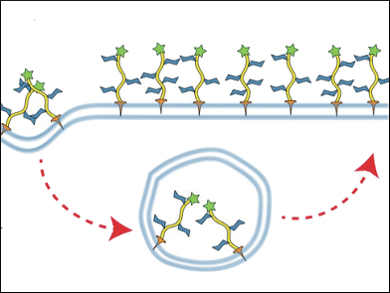Dodging Cell Death
Glycoproteins such as the mucins are assumed to be heavily involved in oncogenesis and metastasic spread. They are part of a strategy developed by malignant cells to resist or dodge the cell death machinery specialized for cells that show insufficient signaling through adhesions. Developing models for the mucins is very challenging, but American scientists have now synthesized glycopolymers that are not only recycled in the membrane, but also prolong the lifetime of healthy cells, as described in the journal Angewandte Chemie.
Glycosylated proteins like the mucins are regarded as responsible for promoting the survival mechanisms of malignant cells by segregating certain signaling proteins in the membrane. A major obstacle to studying this mechanism in detail has long been the lack of suitable model compounds that mimic the mucin functions. The group of Carolyn R. Bertozzi at Stanford University, CA, has now found a way to prepare such model compounds: They synthesize glycosylated polymers with lipid anchors that are readily inserted in the plasma membrane, but, thanks to further attachment of the polymer to a sterol compound, they are not degraded after ingestion in the cell.
Persistent Glycopolymers
The authors explain: “Cholesterylamine, a lipid known to recycle back to the cell surface after internalization, is capable of shuttling glycopolymers through this pathway continuously for up to ten days, resulting in the persistent display of glycopolymers on the plasma membrane.” And, interestingly, the glycopolymers are not only persistent on the plasma membrane, they are also inherited in the dividing cells, as the authors say: “Importantly, the polymers are passed down uniformly from mother cells to daughter cells.”
The observed net persistence of the glycopolymers in the membrane is the result of steady recycling from reservoirs inside the cell. In particular, after initial ingestion in the cell, the CholA-anchored glycopolymers are stored in a depot and shuttled back to the cell surface, as the scientists write, adding: “To the best of our knowledge, these are the most persistent synthetic glycopolymers ever displayed on a cell surface.”
Laying the Groundwork for Applications
Having established their glycoprotein synthetic model, Bertozzi and her colleagues checked for the mechanism by which the glycoprotein-rich cells may evade the programmed cell death called anoikis, which is initiated by insufficient signaling through adhesions: “We tested our polymers for their ability to improve the survival of non-malignant cells in a model of the minimal adhesion setting,” they write. This particular model was the zebra fish embryo, the cells of which turned out to be clearly protected from anoikis by the synthetic glycoproteins.
The preparation of mucin mimetics is a significant step toward the elucidation of the cell survival mechanisms. And apart from purely mechanistic studies, it also lays the groundwork for engineering approaches: “We also envision the utilization of these reagents for translational applications, such as the protection of precious or vulnerable cells from hostile environments or the tailored homing of engineered cells to target tissues,” the researchers state.
- Glycocalyx Engineering with a Recycling Glycopolymer that Increases Cell Survival In Vivo,
Elliot C. Woods, Nathan A. Yee, Jeff Shen, Carolyn R. Bertozzi,
Angew. Chem. Int. Ed. 2015.
DOI: 10.1002/anie.201508783



